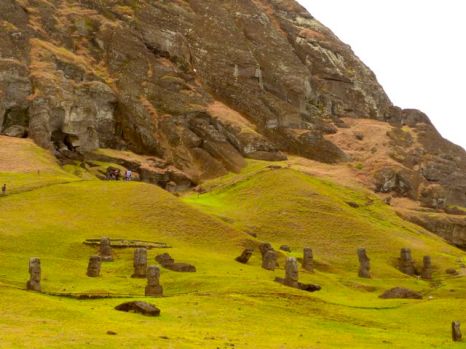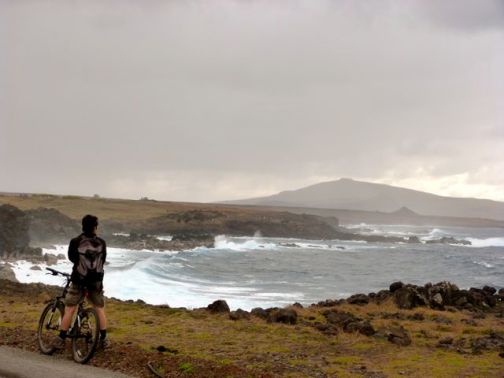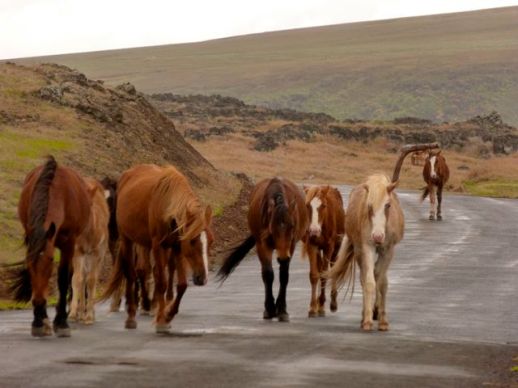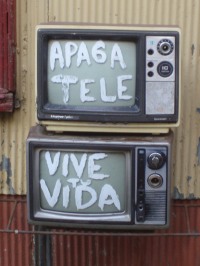As I mentioned in my first post about Rapa Nui a few days ago, I am finding it very difficult to describe how I felt seeing the moai, whether fallen and broken, standing proud on their ahu (stone platform) or half buried in the Rano Raraku quarry. Every moai we saw was distinct and evoked different feelings and thoughts. Although, by the end of the week it was kind of like being in the African bush, where after a few days, you get used to seeing antelope where ever you look and take them for granted.
Having read various blog posts and travel book entries on the island before going, I pretty much knew the typical tourist route that you can basically do in a day. Many posts said that two or three days on the island is enough, or you risk getting bored. In my opinion, these people are downright WRONG. Rapa Nui is SO much more than just a 40km round trip focused on the Moai. So hopefully any future visitors to the island who read my blog will get some ideas of how to make the most of at least 6 days on the island and still feel like it wasn`t enough.
After a crazy few months of work (which lead to me resigning), I was looking forward to this holiday to relax, take it easy, read my kindle and enjoy “island life”. I must admit that after just a few days the pace of life had infected me and I felt like we had been there for weeks. However, it seems like Rodrigo and I are incapable of sitting still for very long and most of our holiday activities are fairly active. The highlights of this trip included a 40km bike ride, 12km hike up a volcano, diving, quad biking and cave exploration.
Unlike 99% of tourists that visit the island, we decided not to hire a 4×4 or go on an organised tour, but instead decided to put our bicycle legs to the test. Apart from three main volcanic cones, the island is fairly undulating and easy to get around on a bike (along the tarred roads at least). We rode the 16km from the town of Hanga Roa to Rano Raraku, the volcanic cone from which the Moai were carved.
The side of the crater is dotted with moai. Try and spot the moai half carved out of the rock face…can you see it?
While riding to Rano Raraku along the coastal road, we were blessed with spectacular views of the rocky shoreline, huge waves pounding the rocks and in various places remnants of once great stone platforms (ahu) with their fallen moai.
Although there are numerous business that rent mountain bikes in the town, it doesn`t seem like many people use them to venture very far. The whole day we came across 1 other guy on a bike. I wouldn`t recommended going to the other end of the island by bike if you are someone who never rides, but if you have a medium level of fitness, it is a great way to explore, at least part of the island, in a day. The only killer hill was on the way back to Hanga Roa, which although not that steep, seemed never ending. I suppose it was made worse by the blazing sun which had decided to come out from the clouds at that point. I was rather grateful that is had been overcast until then, as the sun is really strong on the island.
Apart from the occasional tour bus or 4×4 passing us, and herds of wild horses, we had the road to ourselves.
Rapa Nui is the “odd one out” of the Polynesian Islands. If you have a tropical paradise idea in your head, such as is the case for Tahiti or Hawaii, think again. Rapa Nui is subtropical and the weather is extremely variable. One minute it is cloudy and raining and the next the sun is shining and the clouds have disappeared. The only constant is is the wind.
 The clouds giving way to brilliant afternoon sunshine. The volcano in the photo is Poike, the oldest volcano, said to have erupted 3 million years ago to form the island.
The clouds giving way to brilliant afternoon sunshine. The volcano in the photo is Poike, the oldest volcano, said to have erupted 3 million years ago to form the island.
Anakena Beach is the only part of the island that has a tropical feel to it. It is basically the only beach, so I can`t imagine how crowded it must get in summer.
When we arrived at the beach, it was overcast and drizzling, but yet I decided that after two and a half years in Chile it was finally time that I swam in the Pacific Ocean, which I have never been brave enough to do from the continent (think colder than Cape Town). My first swim in the Pacific was not that successful, as to me it felt as cold as the continent and after running in and dunking myself to neck level I quickly ran out again. At least I was braver than Rodrigo who didn`t make it passed his feet getting wet.
The highlight of an afternoon at Anakena was the tuna and cheese empanada bought from one of 4 local kiosks/restaurants at the beach. Truly, the BEST and biggest empanada in all of Chile (continental/island/austral etc). This photo shows Rodrigo chilling out with the “chef”!
The island is a bit big to get around everywhere on bikes (unless of course you are super fit). So we traded in our bikes for a quad bike. Afterwards I realised that a quad bike cost the same as a small 4×4, but I definitely think it was more fun and actually easier to use on some of the atrocious dirt roads. The route closer to the town (to see Ahu Akivi and Puna Pau) consists of a terrible dirt road and I couldn`t imagine doing that on a bike.
 Despite the quad bike being in my name as I am only one with a valid drivers license, I could tell Rodrigo was having such fun driving over the dirt roads (with little regard for his passenger and the bumps), so he was the “pilot” for most of the trip.
Despite the quad bike being in my name as I am only one with a valid drivers license, I could tell Rodrigo was having such fun driving over the dirt roads (with little regard for his passenger and the bumps), so he was the “pilot” for most of the trip.
The route we did on the quad bike not only took us to some great moai and the quarry where they made the pukau (hats that some of the moai still have), but it also took us to some of the cave networks. Apparently there are about 6km of cave networks on the island.
Ana Kakenga (The “Two Window” cave) is not well signposted and I suppose that is a good thing considering the entrance is quite small and I don`t think going into a cave unprepared is a good idea. But thanks to an adventurous older brother and a childhood spent exploring caves around our farm in South Africa, I felt pretty confident.
The name comes from the fact that at one point the cave splits into two tunnels (lava vents) which open onto the cliffs like two windows.
Despite the smile, Rodrigo was not very fond of being in the cave, even eith it being large and airy. P.S. If you ever find yourself exploring this cave, be very careful as you get to the edge as the drop to the pounding ocean below is well over 30m.
Coming out of the darkness.
Our second caving experience was in the most amazing network of interconnected caverns, some of which had huge holes in the roof which let in the sunlight. This made sections of the “cave” perfect for growing bananas and other crops. The sheltered environment retained water and kept the soil nutritious, unlike the surface of the island, which has always had poor quality, thin volcanic soil.
Looking out of one of the huge caverns towards the “banana patch”
Since coming to Chile I have fallen in love with volcanoes. Every volcano is different, yet the majority of volcanoes on the island are relatively young and still look like your typical snow capped cones. Yet, the three that make up Rapa Nui are extremely old and eroded and don`t look much like volcanoes any more. But they are still amazing sites, especially Rano Kau.
 A short 6km hike from the town is Rano Kau, the most ecologically diverse part of the island, thanks to the environment within the eroded crater. The wall of the crater facing the ocean has been eroded away by the climate.
A short 6km hike from the town is Rano Kau, the most ecologically diverse part of the island, thanks to the environment within the eroded crater. The wall of the crater facing the ocean has been eroded away by the climate.
Rano Raraku, the quarry, from another angle which shows how it is the remnants of a volcanic cone.
This post has been a bit disjointed, jumping from stories of cycling to caving and quadbiking and hiking, and I didn`t have space to even get to the diving, which will have to be a different post. But the main point I want to stress with this story and just a few of the 1000 photos I have, is that the island most definitely is more than just Moai. I think it is so important to not get caught up in the usual sites and experiences of a place (which are obviously impressive), but take time to enjoy the landscapes, do different activities and like I wrote in my last post, get to know the people and culture of a place.













Love this! Tanks for sharing.
Another wonderful read for me whilst I sit and sip my espresso! ( got a nespresso machine ex t & d)…on the veranda, so where to next? Hugs and much love Mum
This leaves quite an impression on me – never a traveller, and not adventurous. Now I am seeing things through your eyes! Love, Esme
Thanks so much Esme, I am happy that I can share my adventures with such appreciative people. It makes it even more worthwhile for me.
My feet are getting ITCHY. YOU NEVER KNOW,I just might win the lotto. hugs and xxxx susan
I would love you to win the Lotto and come and visit Chile and Rapa Nui.